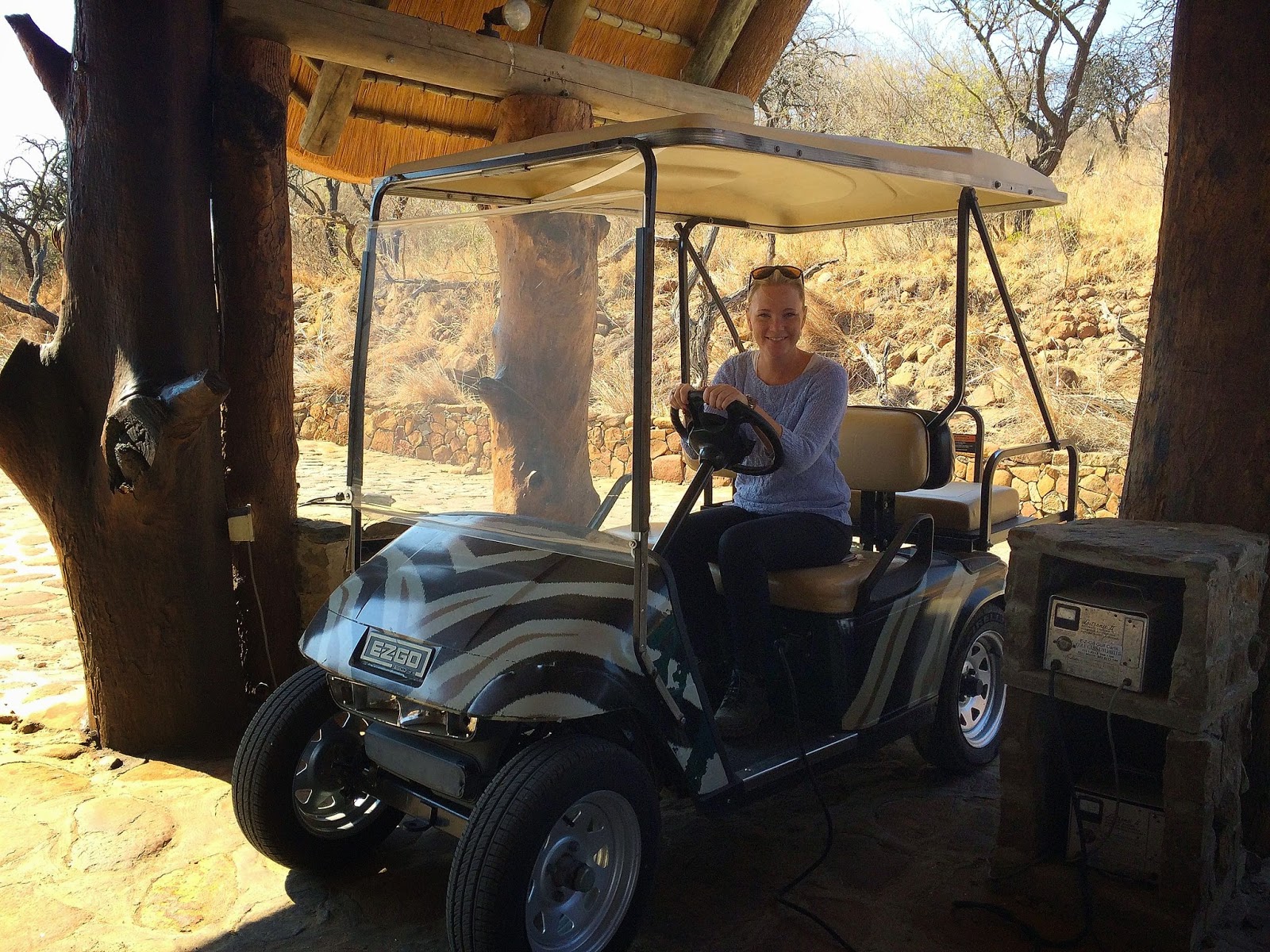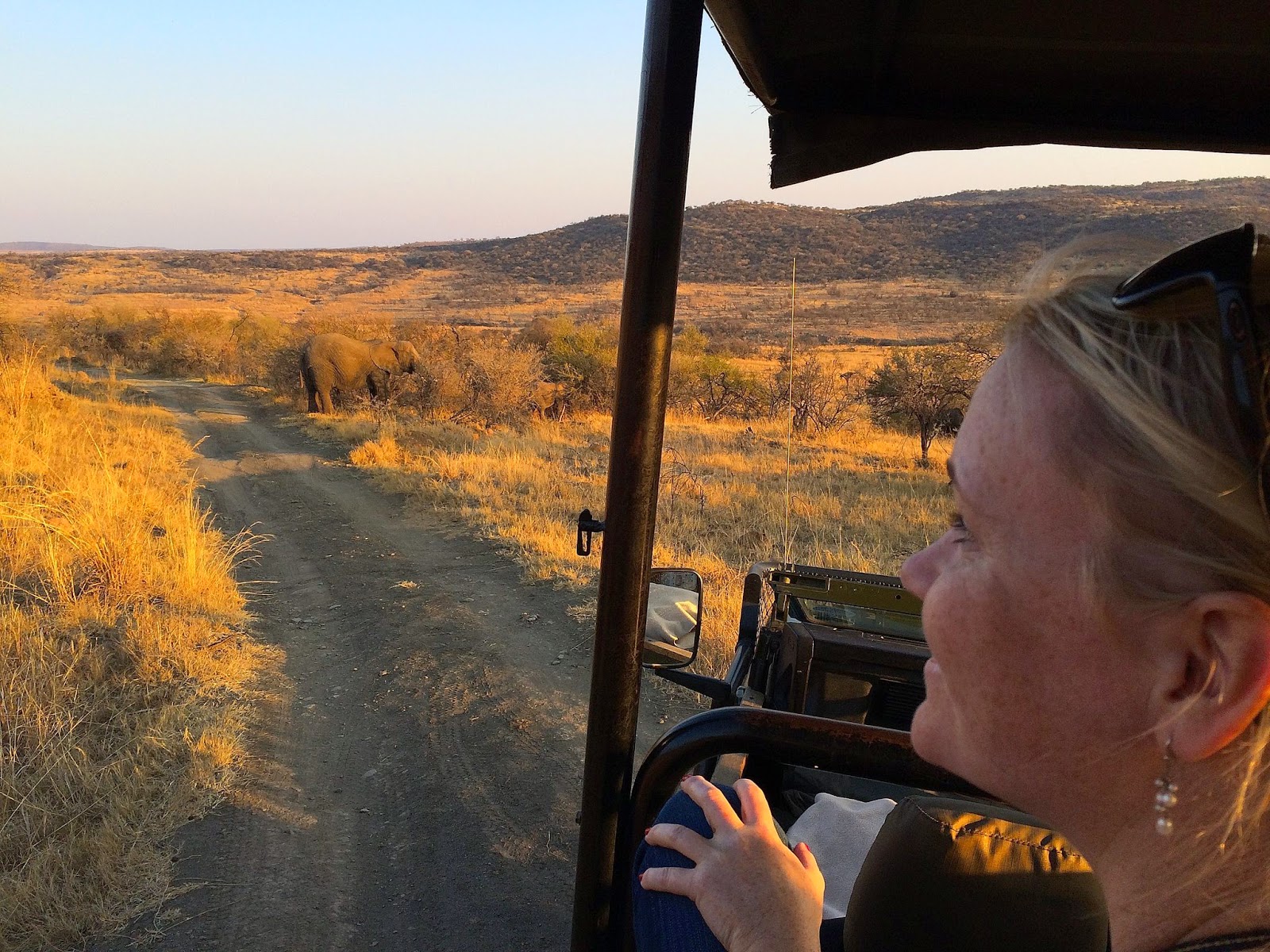Lee, our daughter, Lana and I arrived at the Nambiti Private Game Reserve’s Memorial Gate, on opening the car window, in order to greet the gate guard and get the forms we needed to sign, the heat and varied aromas of the bushveld rushed in, we began to savor our adventure. A run-away fire had crossed into the Nambiti Private Game Reserve on our left and the sour acrid smells added to the away from home smells. Our guide and host for the next few days, Greg, was awaiting our arrival at the car park, keen and ready to show off this special place. We parked our car in the shade and unloaded into the open game viewer.Our transport for the next few days.
Off to Lions Valley Lodge we bounced,
taking in all the heat, sounds, sights and smells. A Black Rhino scent marking here,
some fresh elephant dung there, some wild sage, dust, pollen! Lovely to be out in the
fresh open air.
It is normally an approximate 20 minute drive from the
gate to the Lodge, but not today!.....around a corner and access to Lions Valley Lodge
DENIED!
Well only temporarily. A herd of elephant were wending their way
up the access road and we had to wait their passing. The Matriarch surrounded
by her herd, varying in age and size, posed briefly, then led her entourage
off and away. I always am amazed as to how such enormous behemoths can
seemingly evaporate into the bush.. so quietly too.
With the transfer from the gate to Lodge at 14h00,
temperatures had peaked and the day was rather warm, with most of the animals
recumbent in the shade, from this heat, Greg drove us to the lofty 'coolth' of Lions ValleyLodge’s vast entrance and reception,
....on alighting, on to the numerous public areas which
overlook the nearby water-hole.
Try the rim-flow pool, or one of the recliners
on the expansive view deck. You could be at the bar or in the lounge – all with
views out to the watering point.
 |
| The Bar, lounge with boma beyond |
 |
| Lounge / library |
Most of the rooms have good views of this water-hole
too, from within or from their private decks, although some are a bit further
away.
 |
| Lee pointing out the wildlife |
...which would
ordinarily necessitate quite a walk to ones more remote, secluded suite, but
hey, the Lodge planned this, and built concrete golf cart roads to each, with a
fleet of these mini vehicles.
A phone
call, or ask at reception and a ride at any time is there for you.
 |
| Lee ready to go |
We had arrived to friendly greetings, a welcome drink, indemnity signed, familiarisation of the facilities, luggage ‘golf carted’ to our room and ourselves off to ‘high tea’. Well it’s more like a delightful gourmet luncheon, this is a 5 Star Lodge you know! Meals at a variety of venues at the Lodge.
 |
| The Boma with a view |
 |
| On the Deck |
Then back to our suite to get ready for the afternoon guided game dive in
the ‘open’ Land Cruiser game viewers.
 |
| Lee enjoying a herd of elephant sighting |
 |
| The lion were doing what Lion mostly do, relaxing. Their repose site was rather concealing. |
 |
| The Black Rhino was accidently dehorned in transit - horn broke |
Leopard are rarely seen but do definitely occur in the
Park, all these along with the general game one finds in Zululand. Expect some
seriously good photo opportunities. This reserve has a very high population of
rather relaxed kudu, which is generally not the norm in other game parks.
Zebra are one of my favorite animals!
 |
| With Red-billed oxpeckers |
It is so pleasant to have some sort
of sighting virtually around every corner. Well that’s the Nambiti Private Game
Reserve for you! Some special Avifauna too!
 |
| Secretary bird |
 |
| Room with a view |
 |
| The open-plan bathro0m with private Loo |
 |
| The Africa suite |
What about the rather funky Spaza suite? Lee's choice - we all loved it, so different. Lana and I, by default? had the Romance suite - Again ! We seem to somehow get the Honeymoon suite regularly at various venues.
The meals are really excellent, with epicurean delights
from the kitchen making the dining experience a compliment to this magnificent
venue and the wonderful game viewing generally experienced in the Nambiti GameReserve.
 |
| Fillet of Eland |
The expansive dining room - this normally used during inclement weather
The beautifully appointed Lions Valley Lodge, with its delightful staff, super outlook and location in the Nambiti Game Reserve comes highly recommended by the Far and Wild Safaris Team! For Corporate functions, weddings and such this Lodge has a large, well appointed Conference room as well.
All the above photographs were taken by Jeremy, Lana and Lee
Williamson, on a recent visit to Lions Valley Lodge.






































